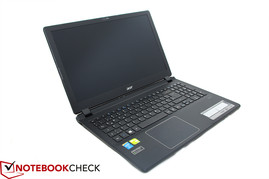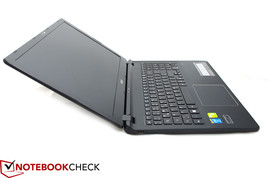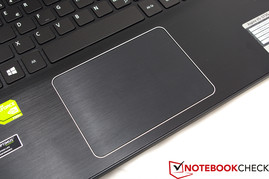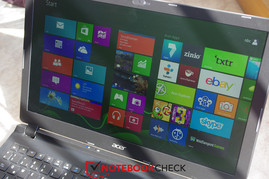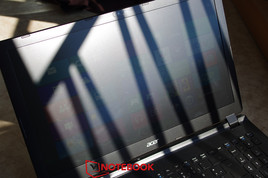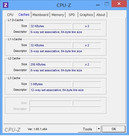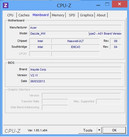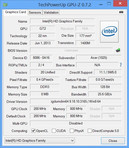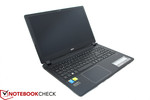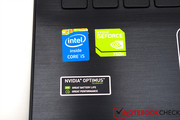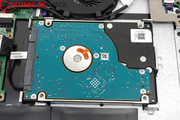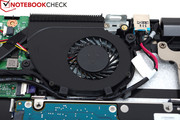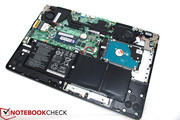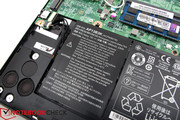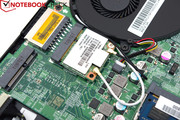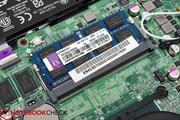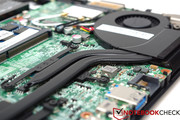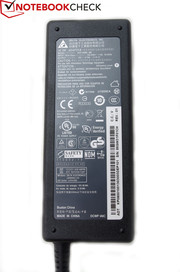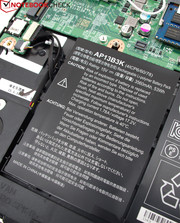Review Acer Aspire V5-573G-54208G50aii Notebook

For the original German review, see here.
The new Acer Aspire V-series is supposed to improve daily PC usage and high-end computing. The manufacturer offers three different versions; our review unit with the designation V5 is right in the middle between the V3 and the V7. The Aspire V5-573 is the successor of the Aspire V5-571 and Acer improved the design and the size of all devices, as a result, the cases are now thinner and lighter. The average price of our configuration is 655 Euros (~$874), which makes it very appealing for working or gaming on the go. Besides our V5-573 in Polar Black, it is also available in Cool Steel, Champagne Ice and Red Blush.
The Aspire V5-573 can be equipped with a Core i3, a Core i5 and a fast Core i7 processor based on the latest Haswell generation. Our review unit uses a current Intel Core i5-4200U processor with a special focus on efficiency. You can choose between HD and Full HD displays with and without a touchscreen. All displays use IPS technology with vibrant colors and high contrast ratios. Our review has a resolution of 1920x1080 pixels and an anti-reflective surface. Graphics are primarily handled by the integrated Intel HD Graphics 4400, which is even suited for some light gaming with its performance. Acer also integrates a GeForce GT 750M (mainstream) into the Aspire V5-573 for more demanding scenarios.
Acer does not use Solid State Drives in the V5-series to achieve the low price. In return, every notebook comes with a mechanical hard drive, with up to 1 TB storage. Our review unit has a 500 GB HDD with no partitions ex-works, so the operating system is together with your personal data on one drive.
Case
Acer uses a mixture of light plastic and metal for the V5. The display cover and the frame are made of plastic and have been improved with a brushed aluminum design on the cover and matte black color for the frame. Due to the matte surface, it does not really attract fingerprints or dust. The palm rest, the only metal piece of the base unit, covers the chassis surface. The maintenance cover and the rest of the case are also made of matte black plastic. Considering its size, the Aspire V5 is very light at just 2,041 grams (~4.5 pounds). Another eye-catcher is the low height of 2.7 centimeters (~1 inch).
The different materials of the palm rest and the base unit around the case result in a clearly visible gap. Especially dirt and dust are collected by the gap, which makes cleaning quite hard. Another critical point is the display or the display frame, respectively. Ex-works it is covered with a protective film. While we removed that film, a part of the display frame separated from the display and we could pull it forwards by around 1 centimeter (~0.4 inches). We cannot say if other devices have the same problem.
Acer did a good job with the hinges of the Aspire V5; they are very well integrated into the base unit and the display. The upper part is flush with the chassis and there are no protruding areas. Opening of the notebook does not require a lot of force and we did not have to hold the base unit down to open the display.
The rigidity of the case is not that good: We can clearly push in the front of the base unit by a few millimeters, but this is just a problem with an opened device. The situation is better when it is closed; we can even lift the Aspire V5 with one hand without twisting it.
You have to remove the whole bottom of the case to replace components or other parts of the Aspire V5. The maintenance cover is fixed with several small screws. After the removal of the cover, you can clearly see the cooling system that transports the heat to the back of the case. The two fans can be easily cleaned. Replacing the hard drive and upgrading the accessible memory module is also very easy.
Connectivity
The Acer Aspire V5 has the usual 2x USB 2.0 ports and 1x USB 3.0 port, but the really interesting part is the port layout. The two USB 2.0 ports are located in the rear area on the left and right side. You can easily attach mice or USB sticks without occupying too much space. The positions of the USB 3.0 port and HDMI port are also very convenient at the back. This improves the cabling and the desk looks more cleaned up. You also have another port at the back, the Acer Converter port. It looks a lot like a Lightning port with its specifications and you can comfortably attach displays, hard drives or routers. Our review unit does not have a DVD- or a BluRay-burner, the whole series is generally too thin for optical drives.
Communication
An Atheros AR5BWB222 WLAN module provides wireless connectivity for the Acer Aspire V5-573. The signal strength of the integrated module is very good; we had the full five bars with a distance of 10 meters (~33 feet). The download speed with a 32 MBit line was excellent with 1.5 MB/s. Only after we left the immediate WLAN range, the signal dropped to three or two bars, respectively, with a distance of around 30-40 meters (~98-131 feet). An additional Ethernet port (Realtek RTL8168) at the back can be used for wired networks. Smartphones or wireless speakers can be connected via high-speed Bluetooth 4.0 and you can make video calls via the integrated webcam with a resolution of 1280x720 pixels.
Accessories
As usual, the provided accessories in the box of the Acer Aspire V5-573 are very limited. Besides the mandatory power cord, there are the necessary documents like user guides and warranty information, but there is no recovery DVD, cleaning cloth nor additional software. You have to use the Acer Recovery Management to restore the system and it can also be used to create a Windows CD.
Maintenance
The whole bottom of the case is one big maintenance cover. The plastic cover is fixed with 17 small screws that can be removed with a Torx screwdriver. We already mentioned that the replacement of components is very easy thanks to the good accessibility. Even the fans can be easily cleaned since they are very far at the back of the device, which means you do not necessarily have to remove the bottom cover.
Warranty
Acer grants a standard warranty period (Carry-In) of 24 months for all notebooks. You can extend that warranty to 3 years for 69.99 Euros (~$93) and to 4 years for 109.99 Euros (~$147). All additional warranties also come with a one-year international warranty.
Input Devices
Keyboard
Acer equips the Aspire V5-573 with a very flat chiclet keyboard and a white background illumination. The keys have a limited travel and a spongy pressure point. The lack of feedback resulted in several typos during our review. The noise development of the keyboard is however very convenient: There is almost no perceptible typing noise due to the limited travel, which makes long typing sessions very comfortable. The layout and the key size are standard and do not deviate from other notebooks; additional keys and special functions are integrated into the row of F-keys.
Touchpad
The touchpad of the Aspire V5 is very large and well built; the buttons are integrated to increase the useable surface. Unfortunately, this creates a serious problem: The touchpad reacts when you are clicking and you often miss the target because the cursor is moving. Acer did not differentiate the buttons from the touchpad, which has a negative impact on the accuracy. The buttons have a short travel and provide a distinct feedback. The necessary force to click the buttons is still okay but can become tiring after long work periods; the best way to use it is with one finger. Operating the Windows 8 user interface is not very convenient with the supported multi-touch gestures. Zooming works well but horizontal scrolling is a nightmare. The touchpad often recognizes two individual fingers and starts applications or moves the cursor instead of scrolling.
Display
The display of the Acer Aspire V5-573 is a matte IPS panel from AU Optronics with a resolution of 1920x1080 pixels. You can even use the display under direct sunlight thanks to the maximum brightness of 311 cd/m². We determined the lowest brightness of 239 cd/m² in the lower right corner. This results in a brightness distribution of just 76%, but that is barely visible due to the sufficient luminance.
| |||||||||||||||||||||||||
Brightness Distribution: 77 %
Center on Battery: 290 cd/m²
Contrast: 1196:1 (Black: 0.24 cd/m²)
ΔE ColorChecker Calman: 4.8 | ∀{0.5-29.43 Ø4.78}
ΔE Greyscale Calman: 5 | ∀{0.09-98 Ø5}
61% AdobeRGB 1998 (Argyll 1.6.3 3D)
64.6% AdobeRGB 1998 (Argyll 3D)
89% sRGB (Argyll 3D)
64.1% Display P3 (Argyll 3D)
Gamma: 2.7
CCT: 6360 K
We really have to emphasize the excellent contrast ratio of 1,301:1 that is enabled by the low black value of the IPS panel. Ex-works (pre-calibration) we determined a yellow cast, but it was minimized after the calibration and not visible anymore. The color temperature of 6340 K is also close to the ideal value of 6500 K; only the gamma value deviates significantly from the ideal value (2.2) with 2.7. The black value of 0.22 cd/m² is excellent and results in crisp blacks without a visible gray film.
The Acer's coverage of the available color spaces is on a very high level. With more than 90% of the sRGB color space, the IPS display of the Aspire V5-573 is superior to most TN-panels. 61.8% coverage of AdobeRGB is also very good.
Web browsing in the park or on the terrace is no problem with the Acer Aspire V5-573. Thanks to the high contrast ratio and the high brightness of the matte display, you can even see the display content under direct sunlight. As a result, you can adjust the brightness in the shade and still see web sites or the Windows 8 interface.
Performance
The display of the Aspire V5-573 is certainly a highlight, but what about the performance? The multimedia notebook uses an Intel Core i5-4200U processor based on the latest Haswell architecture. It has a nominal clock of 1.6 GHz, which can be raised up to 2.6 GHz via Turbo Boost. The "U" in the designation indicates that the Core i5-4200U is an Ultra-Low-Voltage processor with a maximum TDP of 15 Watts. Similar to all the other current Intel CPU's, the Core i5-4200U is also equipped with an integrated GPU (Intel HD Graphics 4400) that clocks between 200 and 1,000 MHz.
You can also use the dedicated graphics card from Nvidia for more demanding scenarios or higher resolutions. The GeForce GT 750M is a mainstream DirectX-11 graphics card and is produced in 28 nm by TSMC. The storage solution of the Aspire V5-573 is not an SSD but a conventional hard drive; none of the currently available V5 configurations is equipped with the fast flash storage. System memory is eight GB DDR3-RAM clocked at 1,600 MHz. The notebook has two memory slots, which are both occupied. As a result, the memory is working in dual-channel mode.
Processor
The Intel Core i5-4200U processor is basically the successor of the older Core i5-3337U. Instead of 1,800 MHz for the Core i5-3337U, the new Haswell Core i5-4200U is only clocked at 1,600 MHz. As expected, the performance of the Intel Core i5-4200 based on the latest Haswell architecture is similar to the predecessor. Cinebench R11.5 Single determines 1.13 points for the new processor, devices like the HP Spectre XT TouchSmart 15-4000eg or the Acer Aspire V5-571PG-53314G75Mass with a Core i5-3337U fall behind by around 5%. CB R11.5 Multi results in 2.45 points for the Acer Aspire V5-573; once again, the new Haswell processor manages an advantage of around 5% over the Intel Core i5-3337U.
However, the performance on battery power is somewhat disappointing. Even with the High Performance energy setting of Windows 8, the Intel Core i5-4200U does not use its Turbo Boost. The steady 1.6 GHz result in a significant performance drop of around 29% in Cinebench R11.5 Multi compared to the results with the attached PSU. However, this is not apparent during web browsing or other less demanding tasks.
| Cinebench R11.5 - CPU Multi 64Bit (sort by value) | |
| Acer Aspire V5-573G-54208G50aii | |
| Asus VivoBook S551LB-CJ026H | |
| Lenovo G500s-59367693 | |
| MSI GE70-i765M287 | |
System Performance
Conventional hard drives are often the bottleneck when it comes to system performance and the Acer Aspire V5-573 is no exception. The combination of an Intel Core i5-4200U and the 500 GB hard drive manages 2,878 points in PCMark 7, which is comparable to notebooks with smaller CPU's. The Acer Aspire M3-481-53314G50 with the identical hard drive and an Intel Core i5-3317U, for instance, is only 5% slower with 2,731 points. However, if you use a hard drive with an SSD cache (Sony Vaio SV-T1511M1E/S), even an older system with the Core i5-3337U can clearly beat the Acer Aspire V5-573 by 21%. The combination of a Core i5-4200U and an SSD, for example in the Sony Vaio Duo 13 SVD1321M2E, gets a result of 4,594 points. That is an increase of 60%.
Fortunately, the low PCMark results do not reflect the overall performance of the notebook. Working with the Acer Aspire V5-573 is smooth and we could not determine any lags. Even several applications or browser tabs were no problem for the device.
| PCMark Vantage Result | 6008 points | |
| PCMark 7 Score | 2878 points | |
| PCMark 8 Home Score Accelerated | 2683 points | |
| PCMark 8 Creative Score Accelerated | 2623 points | |
| PCMark 8 Work Score Accelerated | 4001 points | |
Help | ||
Storage Solution
Acer equips the Aspire V5-573 exclusively with mechanical hard drives; our review unit uses a Seagate Momentus Thin ST500LT0 12 with 500 GB storage. The performance of the HDD is average according to HD Tune and CrystalDiskMark. HD Tune determines a minimum transfer rate of 45.3 MB/s; the maximum transfer rate of 109.9 MB/s is reasonable.
Graphics
Graphics are handled by the Intel HD Graphics 4400, which is integrated into the processor. The GPU supports DirectX-11, is clocked between 200 and 1,000 MHz and should provide sufficient performance for less demanding games. Our benchmarks indicate a good performance of the Intel HD Graphics 4400. You can use Nvidia's Optimus technology to switch to the dedicated GeForce GT 750M if you need more performance.
The GeForce GT 750M is a mainstream GPU and was launched back in spring 2013. The GPU with the designation GK107 is produced in a 28 nm manufacturing process by TSMC. Our GeForce GT 750M has 4,096 MB memory and a 128-bit memory interface. The GPU has a nominal clock 967 MHz, which can also be raised via Turbo Boost to get more performance, similar to Intel processors. Our stress test with Prime95 and FurMark shows that the GeForce GT 750M maintains a clock of 1,071 MHz even after 20 minutes; the temperature climbed to 89 °C (192.2 °F) in this scenario. Despite the high temperatures, we could not determine any reduction of the GPU clock during the FurMark run.
3D Mark 11 determines a result of 2,462 points for the GeForce GT 750M, which is just between the GeForce GT 650M and the GeForce GTX 660M. We did not a review a direct comparison model so far, but the Asus N750JV uses the same graphics card with a better Intel Core i7-4700HQ processor. Our review unit and the Asus are only separated by 11%; the N750JV has an advantage of 173 points because of the faster processor. If you are more interested in efficiency than performance, you can also activate the Intel HD Graphics 4400 in the GPU driver. The integrated Intel graphics manages a reasonable 969 points in 3D Mark 11.
| 3DMark 06 1024x768 Score | 11844 points | |
| 3DMark Vantage P Result | 8002 points | |
| 3DMark 11 Performance | 2462 points | |
| 3DMark Ice Storm Standard Score | 39694 points | |
| 3DMark Cloud Gate Standard Score | 5855 points | |
| 3DMark Fire Strike Score | 1420 points | |
Help | ||
Gaming Performance
The gaming performance of the Acer Aspire V5-573 is very good for a multimedia notebook thanks to the dedicated GeForce GT 750M. We already mentioned that we do not have many devices for comparison; once again, we are using a better-equipped notebook. Tomb Raider's benchmark indicates 65.4 frames per second with medium details, sufficient for smooth gaming. The performance is even sufficient for high settings with 39.8 fps without any dropped frames. However, Full HD resolution in combination with the highest quality setting was too much for the notebook, we determined dropped frames and Tomb Raider was only playable with 17.9 fps. A faster processor for the Aspire V5 would only have a small impact of 3%; both the One K56-3F and the Asus N550JV-CN201H show that Tomb Raider does not really benefit from a faster CPU.
The situation is different with Metro: Last Light, where we can see the limitations by the processor. The GeForce GT 750M manages smooth 30.8 frames per second with medium details in the integrated benchmark; the Asus N750JV-T4110H gets 36.1 fps thanks to its Core i7-4700HQ. This is a 17% advantage for the Asus, but is also more expensive. The integrated Intel HD Graphics 4400 shows a result of 17.4 frames per second in the Metro: Last Light benchmark with medium details and 23.3 fps with the lowest quality settings.
Games with high processor demands show a bigger limitation. F1 2012 is such a title and quickly results in low frame rates on notebooks with a mainstream GPU and an ULV processor. This is especially evident with the low quality setting, where the Acer Aspire V5-573 with such a GPU/CPU combination only manages comparatively low 96 fps. The Asus N750JV-T4110H has the same GPU but a much better processor; the result is a performance advantage of 67% with around 160 frames per second. However, this difference becomes negligible when we increase the graphics quality. The result is 74 fps for the Aspire V5-573 while the Asus N750JV-T4110H only manages three frames per second more, which translates to an advantage of 4%. Ultra settings only show a difference of 1 fps between the Acer Aspire V5-573 and the Asus N750JV-T4110H.
| low | med. | high | ultra | |
|---|---|---|---|---|
| F1 2012 (2012) | 96 | 80 | 74 | 32 |
| Tomb Raider (2013) | 120.4 | 65.4 | 39.8 | 17.9 |
| BioShock Infinite (2013) | 86.1 | 51.2 | 43.62 | 13.18 |
| Metro: Last Light (2013) | 38.17 | 30.8 | 19.33 | 10.2 |
| GRID 2 (2013) | 124 | 79 | 57 | 18 |
| Company of Heroes 2 (2013) | 27.86 | 21.61 | 14.95 | 6.73 |
| Company of Heroes 2 - 1366x768 Medium AA:Off (sort by value) | |
| Acer Aspire V5-573G-54208G50aii | |
| Asus VivoBook S551LB-CJ026H | |
| F1 2012 - 1366x768 Medium Preset (sort by value) | |
| Acer Aspire V5-573G-54208G50aii | |
| Asus N56VB-S4050H | |
| Tomb Raider - 1366x768 Normal Preset AA:FX AF:4x (sort by value) | |
| Acer Aspire V5-573G-54208G50aii | |
| Asus N56VB-S4050H | |
| Lenovo G500s-59367693 | |
Emissions
System Noise
Despite the compact case, the two fans of the Acer Aspire V5-573 are surprisingly quiet. We measured a maximum of 33.3 dB(A) during idle, which is similar to a quiet murmur. Only the mechanical hard drive produces audible noise when it is active. However, we can clearly hear the restraints of the compact case under load, where the fans have to work harder. We measure values up to 43.6 dB(A) for the Aspire V5-573, which is comparable with a gaming notebook.
Noise level
| Idle |
| 30.8 / 33.3 / 33.3 dB(A) |
| HDD |
| 32.1 dB(A) |
| Load |
| 40.9 / 43.6 dB(A) |
 | ||
30 dB silent 40 dB(A) audible 50 dB(A) loud |
||
min: | ||
Temperature
The Acer Aspire V5-573 is a very thin notebook with a height of just 2.7 cm (~1 inch) that is equipped with comparatively high performing hardware. This is also the reason for the dual fan cooling solution. Heat pipes transport the heat from the processor and the graphics card to the fans in the back of the notebook. One advantage of this solution is that only the back of the notebook gets noticeably warmer; the palm rest and a large part of the keyboard are not affected. We measure the highest temperature of the Aspire V5-573 at the upper left corner on the bottom: Around 62 °C (143.6 °F) in our stress test. This is the area where the heat from the graphics card is dissipated. The maximum temperature on the other side is 60 °C (140 °F).
Acer did a good job with the temperatures at the top. Although we determine temperatures of 52-57 °C (125.6-134.6 °F) in the center area above the keyboard, the palm rest stays cool under load with just 27-31 °C (80.6-87.8 °F). The WASD-keys warmed up to 35 °C (95 °F), which is still acceptable. However, we could not reach this value during gaming, so the primary input area always remains pleasant.
The CPU temperature climbed to 90 °C (194 °F) during our stress test with Prime95 and FurMark; considering the case dimensions this is a decent result. It is impressive that the Intel Core i5-4200U shows no sign of thermal throttling even after 30 minutes; the clock leveled off at 2.2 GHz after a few minutes. The GPU also reached high temperatures of 89 °C (192.2 °F) with the active Turbo Boost, but the clock was 1,071 MHz for the whole FurMark run.
(-) The maximum temperature on the upper side is 57.9 °C / 136 F, compared to the average of 36.9 °C / 98 F, ranging from 21.1 to 71 °C for the class Multimedia.
(-) The bottom heats up to a maximum of 62.1 °C / 144 F, compared to the average of 39.2 °C / 103 F
(+) In idle usage, the average temperature for the upper side is 29.7 °C / 85 F, compared to the device average of 31.3 °C / 88 F.
(+) The palmrests and touchpad are cooler than skin temperature with a maximum of 31.6 °C / 88.9 F and are therefore cool to the touch.
(-) The average temperature of the palmrest area of similar devices was 28.7 °C / 83.7 F (-2.9 °C / -5.2 F).
Speakers
Acer equips the Aspire V5-573 with four speakers for a rich surround sound. The speakers are directly below the palm rest and consist of two drivers each. The sound experience of the Aspire V5 is clear and very powerful; the speakers use the case as a sound box and create a rich sound. Movies and TV series sound good and can convince in hectic and quite scenes. Even genres with focus in bass, like Hip Hop or Electro, sound very good. Metal and Folk can be slightly distorted with high volumes but the quality is still on a high level.
Energy Management
Power Consumption
The energy consumption of Acer's 15.6-inch notebook is as frugal as it is thin and light. Despite the high brightness of the Full HD IPS panel we measured a maximum consumption of 11.2 Watts during idle with maximum display brightness and activated WLAN. The situation changes under load where the GeForce GT 750M consumes more energy. The maximum consumption of the Acer Aspire V5-573 during our stress test with FurMark and Prime95 was 77.5 Watts.
| Off / Standby | |
| Idle | |
| Load |
|
Key:
min: | |
Battery Runtime
The Aspire V5-573 is an ultra mobile notebook with a large display and decent performance reserves. Typical for this notebook class is the appealing battery runtime, even with maximum display brightness and activated wireless connection. The manufacturer equips the notebook with a 53 Wh battery that should provide good battery runtimes considering the reasonable consumption values. During idle and with minimum display brightness, the runtime of the Acer Aspire V5-573 is 8:47 hours; a gaming session only lasts 2:05 hours due to the high consumption of the dedicated graphics card. The runtime during web browsing is more convincing; medium display brightness and activated WLAN result in 7:09 hours for the Aspire V5. This is a very good result. We can see the effects of the bright and high-contrast display when we watch a video; we set the display brightness to maximum for this test and the battery runtime is significantly shorter compared to our WLAN scenario. However, the notebook still manages 4:09 hours of movie playback.
Verdict
The Acer Aspire V5-573 is quite impressive; the manufacturer offers an interesting product with its latest ultra-thin notebook, especially for private users and gamers. The combination of an Intel Core i5-4200U, a GeForce GT 750M and the 500 GB hard drive is available for around 650 Euros (~$867). For this price, you get a fast, thin notebook with gaming ambitions.
One highlight for this price is certainly the bright display with a high contrast ratio. The IPS panel with a resolution of 1920x1080 pixels is convincing in every situation. It does not matter if you are in the park or on the terrace - you can always see the display content. The speakers are also convincing, they manage to produce a rich and spatial sound despite the limited case dimensions.
The Acer Aspire V5-573 does have a few small drawbacks: The area above the keyboard gets very warm because of the small case but that should not really affect the usability. The imprecise touchpad on the other hand is a bigger problem; it is not comfortable to use.
All in all, we can recommend the Aspire V5-573 because of the excellent display and the good performance.




